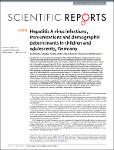Hepatitis A virus infections, immunisations and demographic determinants in children and adolescents, Germany
Michaelis, Kai
Poethko-Müller, Christina
Kuhnert, Ronny
Stark, Klaus
Faber, Mirko
Hepatitis A is a vaccine-preventable disease with a global distribution. It predominantly occurs in regions with inadequate living conditions, but also affects populations in industrialised countries. Children are frequently involved in the transmission of hepatitis A virus (HAV) and thus play a central role in the epidemiology of hepatitis A. Here, we investigated HAV infections, immunisations, and associated demographic determinants in a nationwide, population-based, cross-sectional survey conducted in Germany from 2003–2006. Out of 17,640 children and adolescents, complete data sets (HAV serology, demographic information and vaccination card) were available for 12,249 (69%), all aged 3–17 years. We found protective antibody levels (>=20 IU/L) in 1,755 (14%) individuals, 1,395 (11%) were vaccinated against hepatitis A, 360 (3%) individuals were HAV seropositive without prior hepatitis A vaccination, thus indicating a previous HAV infection. Antibody prevalence (attributable to vaccination or infection) increased significantly with age. Multivariate logistic regression revealed that predominantly children and adolescents with migration background–even if they were born in Germany–are affected by HAV infections. Our results provide a rationale to emphasise existing vaccination recommendations and, moreover, to consider additional groups with a higher risk of infection for targeted vaccination, especially children with a migration background.

